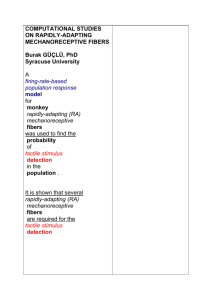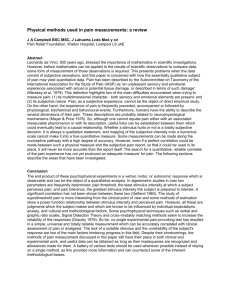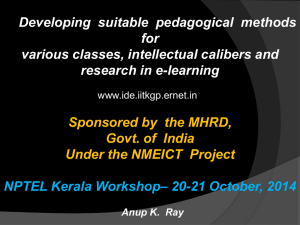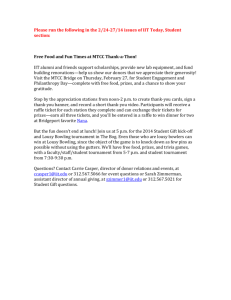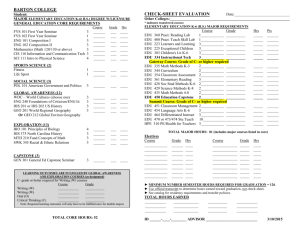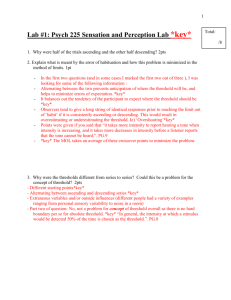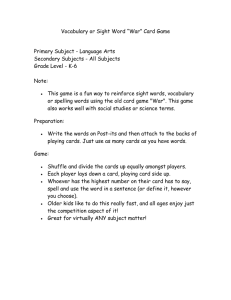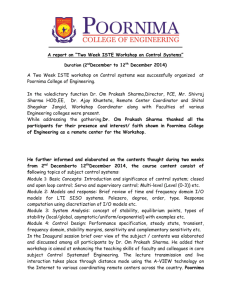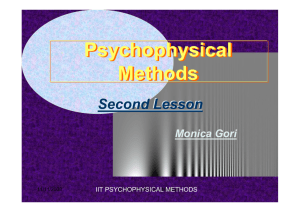Psychophysical Methods Psychophysical Methods
advertisement
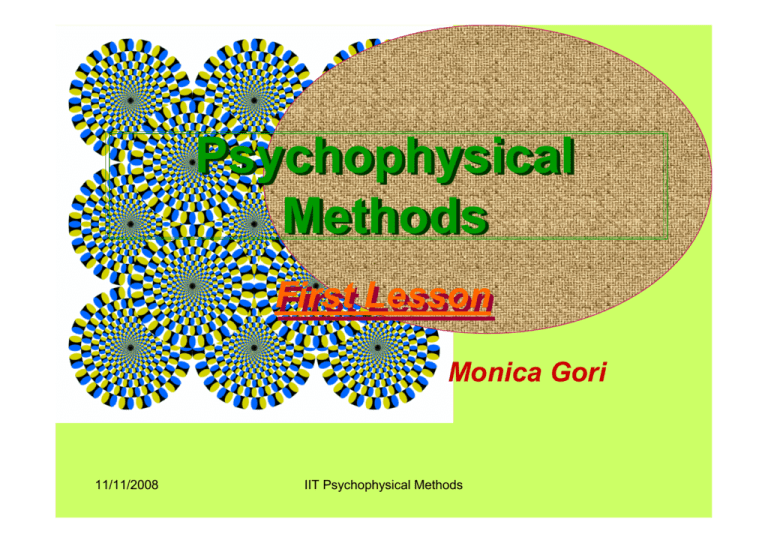
Psychophysical Methods First Lesson Monica Gori 11/11/2008 IIT Psychophysical Methods Course Outline • • • • • • • • • • • What is Psychophysic? History and example experiments Concept of threshold Absolute Threshold + examples Differential Threshold + examples Classical Psychophysical Methods with experiments examples. Methods of constant stimuli + examples Methods of adjustment + examples Methods of limits + examples Signal Detection Theory How to design an experiment 11/11/2008 IIT Psychophysical Methods Today Lesson’s Outline • • • • • • • • • • • What is Psychophysics? Concept of Sensation Is perception veridical? History of Psychophysic Sensory Threshold introduction to Absolute Threshold introduction to Differential threshold Sensation dimensions Weber’s low Concept of Noise Fechner ‘s law 11/11/2008 IIT Psychophysical Methods Textbook • Psychophysics the fundamentals, George A. Gescheider 11/11/2008 IIT Psychophysical Methods What is Psychophysics? – Definition • Psychophysic investigate the relationship between sensation (ψ) in the psychological domain and stimuli (Φ) in the physical domain • It refers to the methodology of studying perception (designing experiments, formulating models) 11/11/2008 IIT Psychophysical Methods Do we all perceive things the same way? Figure Ground Segregation Glass Patterns Movie 11/11/2008 IIT Psychophysical Methods Sensation • For centuries thinkers have recognized the importance of understanding sensation in order to answer many questions like for examples: 1. 2. 3. 4. Is the perception an active or a passive process? Is perception veridical? Can perceptual mechanisms be modified? Can we integrate different signals from different sensory modalities? 11/11/2008 IIT Psychophysical Methods 1. Is the perception an active or a passive process? • Do I only receive and elaborate information from the external environment or can I also use these signals in order to interpret future ones? • Is the perception an active or a passive process? 11/11/2008 IIT Psychophysical Methods 2. Is perception veridical? • Do the perception reflect the physical stimulus or it is not veridical? Glass-Anti Glass Patterns Movie 11/11/2008 IIT Psychophysical Methods Kitaoka & Ashida (2003) 2. Is perception veridical? • Do the perception reflect the physical stimulus or it is not veridical? • Are these signal conscious to myself or not? 11/11/2008 IIT Psychophysical Methods 3. Can perceptual mechanisms be modified? Motion aftereffects (demo) • The mechanisms of motion aftereffects are well understood. The brain has a variety of neurons that detect motion in a particular direction. • If some motion detectors continuously respond to motion for a while, they tire or adapt to that motion and become less active. • When the motion is stopped, different motion detectors, especially those for the opposite direction, become active, and give rise to the illusory motion in that direction. 11/11/2008 IIT Psychophysical Methods Do we all perceive things the same way? Binocular Rivalry If the two eyes see very disparate images, like in this stereogram, humans experience binocular rivalry: after a short time-delay during which one sees both images superimposed, perception then alternates in a random fashion between the left and right view of the scene. 11/11/2008 IIT Psychophysical Methods 4. Can we integrate different signals from different sensory modalities? Visual Auditory Haptic Others.............. Sensory fusion No information-processing system is powerful enough to ‘perceive and act’ accurately under all conditions. The key to robust perception is the combination and integration of multiple sources of sensory information. Ernst & Bülthoff TICS 2004 11/11/2008 IIT Psychophysical Methods Sensory Combination Visually: contrast color...... Haptically: weight temperature.... It occurs when different environmental properties of the same object are estimated by different sensory modalities Sensory Integration It occurs when the same environmental property is estimated by different sensory modalities Cross Modal interaction integration and combination • Smarties Effect: “Assessing the Role of Color Cues and People's Beliefs About Color–Flavor Associations on the Discrimination of the Flavor of Sugar-Coated Chocolates” Carmel A. Levitan1, Massimiliano Zampini1,2,3, Ryan Li1 and Charles Spence Chemical Senses 2008 33(5):415-423; doi:10.1093/chemse/bjn008 • McGurk effect • Ventriloquist Effect • Flash tap Effect 11/11/2008 IIT Psychophysical Methods McGurk effect (demo) • Can perceptual modalities interact? The McGurk effect (named after Harry McGurk of McGurk & McDonald, 1976) is a compelling demonstration of how we all use visual speech information. The effect shows that we can't help but integrate visual speech into what we 'hear'. 11/11/2008 IIT Psychophysical Methods The “ventriloquist effect” Previous explanations of ventriloquist effect •Magic. •Vision “captures” sound: inherent dominance of vision. 11/11/2008 Example of ventriloquist effect IIT Psychophysical Methods Alais and Burr Current Biology 2004 11/11/2008 IIT Psychophysical Methods Bresciani et.al. 2005 Exp. Brain. Research Rock & Victor Experiment (1960) The Lens introduce a Visual Haptic Conflict Matched with visual size: Vision Dominates Visual perception 11/11/2008 Haptic perception IIT Psychophysical Methods Unimodal domination • Visual-audio domain: Shams et al. (2002) showed that when a single visual flash is accompanied by multiple task irrelevant auditory beeps, the single flash is perceived as multiple flashes. • Audio-tactile domain: Hötting and Röder (2004) and Bresciani et.al (2004) found that one tactile tap accompanied by multiple auditory tones is perceived as more than a single tap. 11/11/2008 IIT Psychophysical Methods Unimodal Dominance • Auditory system dominates in the temporal domain • Visual system dominates in the spatial domain (i.e. shape, size or position) Is it a real dominance or is it possible that both modalities somehow contribute to the final percept? 11/11/2008 IIT Psychophysical Methods Humans integrate visual and haptic information in a statistically optimal fashion Marc O.Ernst e Martin S.Banks Nature Vol 415 January 2002 To quantify the multimodal integration across senses Optimal combined estimate of size SˆVH = wH Sˆ H + wV SˆV Improvement of threshold 11/11/2008 Virtual Reality IIT Psychophysical Methods Illusions and Art Forever Always of Octavio Ocampo Relativity of Escher 11/11/2008 IIT Psychophysical Methods "Not to be Reproduced" of René Magritte Disappearing Bust of Voltaire of Salvador Dali’ History • The problem of psychophysics constitute some of the most fundamental problems of modern psychology. • Prior of a century ago the approach to psychological problems consisted primarily of philosophical speculation. 11/11/2008 IIT Psychophysical Methods History • The transition of psychology from philosophical to a scientific discipline was facilitated when G. T. Fechner introduced techniques for measuring mental events. • In 1860 Fechner published “Elements of psychophysics” where provide methods and theory for the measurement of sensation. Fechner 11/11/2008 IIT Psychophysical Methods History • Experimental psychology was established as an independent sciences when Wundt (1879) founded the first laboratory for experimental work exclusively directed toward understanding psychological processes. • The work of Wundt evolved from British empiricist and associationist schools of philosophy that establish the idea that senses are the key to human understanding. This idea was reinforced by advances in sensory physiology. 11/11/2008 Wundt in the Laboratory at Leipzig IIT Psychophysical Methods Principal Problem • How to establish the relation between perceptions and the underlying brain mechanisms? • The goal of perception is to acquire accurate and reliable information about the environment. 11/11/2008 IIT Psychophysical Methods Sensory Threshold • The central concept of Psychophysic is that of sensory threshold. • “Mental events had to be stronger than some critical amount in order to be consciously experienced” Herbart (1824) • Weber and Fechner were interested in the measurement of the sensitivity limits of the human sense organs. • Using measurement techniques of physics and well trained human observes, were able to specify the weakest detectable sensation in terms of stimulus energy necessary to produce them. 11/11/2008 IIT Psychophysical Methods Absolute Threshold • The absolute threshold was defined as the smallest amount of stimulus energy necessary to produce a sensation. 11/11/2008 IIT Psychophysical Methods Absolute Threshold • Since an organism’s sensitivity to external stimuli tends to fluctuate somewhere from moment to moment, several measurements of the threshold value of the stimulus are averaged to arrive an accurate estimation of absolute threshold. 11/11/2008 IIT Psychophysical Methods Absolute Threshold • Perceptual representation of a stimulus is not constant; it involves an additive random error. It follows that the psychometric function is not a step-function. Instead it is an S-shaped curve. • AT is defined as the 50thpercentilepoint 11/11/2008 IIT Psychophysical Methods Experiment Differential threshold • When a stimulus above absolute threshold is applied to the sense organ, the intensity of the stimulus must be increased or decreased by some critical amount before a person is able to report any change in sensation. 11/11/2008 IIT Psychophysical Methods Differential Threshold Difference threshold is the smallest difference between two stimuli that can be reliably detected 11/11/2008 IIT Psychophysical Methods Just noticeable difference • The difference threshold was defined as the amount of change in a stimulus (∆ Φ) required to produce a just noticeable difference ( jnd ) in the sensation. • Intensity stimulus=10 units • Stimulus must be increased to 12 units to produce a just noticeable increment in the sensation • Difference threshold=2 units 11/11/2008 IIT Psychophysical Methods Experiment Sensation dimensions Intensity isn’t the only way in which sensation can differ. Sensation can differ an at least four basic dimensions: • Intensity • Quality • Extension • Duration 11/11/2008 IIT Psychophysical Methods Sensation dimension: quality Between modalities, kind of sensation (seeing different from hearing) Within the same modality (higher or lower sound, variation in wavelength of light, cutaneous sensation: pain warmth, cold, pressure) 11/11/2008 IIT Psychophysical Methods Sensation dimension: extension • By varying along the dimension of extension, the DT can be measured for variation in spatial aspect of the physical stimuli such as: Size Location Separation 11/11/2008 IIT Psychophysical Methods Sensation dimension: duration • Since sensation last for varying periods of time, the DT was measured for different duration of the stimulus. 11/11/2008 IIT Psychophysical Methods Differential threshold • Differential threshold is measured for example for: Auditory pitch discrimination for changes in frequency Colour discrimination for the perception of changes in the wavelength of light 11/11/2008 IIT Psychophysical Methods Work in Psychophysic • Much work in Psychophysic has consisted of investigating how absolute an difference thresholds change as some aspect of the stimulus is varied (wavelength, frequency, adaptation, time, intensity, level, etc.) • The resulting relation are called stimulus critical value functions, since they describe how the threshold changes as a function of other aspects of the stimulus. • Psychophysical experiments allow making inferences about many aspects of perception. 11/11/2008 IIT Psychophysical Methods Weber’s law Relation between the difference threshold for intensity and the intensity level of the stimulus: i.e. Difference threshold=2 units if intensity level of the stimulus=10 units And when the intensity level of the stimulus=20,30,40 or 50 units? 11/11/2008 IIT Psychophysical Methods Weber’s law • Weber (1834) discover that the size of the difference threshold was linear function of the stimulus intensity Weber ‘s law: the change in the stimulus intensity that can just be discriminated (∆Φ) is a constant fraction (c) of the starting intensity of the stimulus (Φ) ∆Φ=cΦ or ∆Φ/ Φ =c • Thus, increases in the intensity of the stimulus that were just noticeably different to the observer were always a constant fraction of the stimulus intensity. 11/11/2008 IIT Psychophysical Methods Weber’s law • Below is a plot of some hypothetical data showing Weber's Law. The slope of the line is the Weber fraction. ∆Φ/ Φ =c For a fairly wide range of stimulus intensities 11/11/2008 IIT Psychophysical Methods Weber’s law • Whether the stimulus is applied to eye, skin, nose, tongue or other senses there is a lawful relationship between the size of the difference threshold and the stimulus intensity level. • valid for a wide range of stimulus intensities • it is good as a baseline to compare performance • not always true->increase greatly at extremely low stimulus intensities. 11/11/2008 IIT Psychophysical Methods Weber’s law Weber fraction for lifted weights. For 2 observers was nearly contact over the stimulus range, except for the lowest stimulus values (Engen 1971) 11/11/2008 IIT Psychophysical Methods Weber’s law • Weber fraction provide an index of sensory discrimination that can be compared over different conditions and different sensory modalities. • i.e. you can’t compare ∆Φ for vision in luminosity units with ∆Φ for audition in sound pressure units but you can compare the two modalities through the weber fraction comparison 11/11/2008 IIT Psychophysical Methods Ongoing experiment • Now we will try to measure discrimination threshold for visual and haptic modalities by varying our stimulus intensity. • Two group will evaluate the visual discrimination thresholds for base stimulus intensities of 5-6-7 cm. • Two group will evaluate the haptic discrimination thresholds for base stimulus intensities of 5-6-7 cm. • Then we will extract the Weber’s law for each group and each modality and we will compare them. 11/11/2008 IIT Psychophysical Methods Temporal Frequencies Threshold (Hz) Weber’s law and dipper function A. Only vision B. Only tactile MG MG C. Bimodal Same Direction D. Bimodal Opposite Direction 3.3 c/deg cg3.3 10cg 10 c/deg MG 10 MG 5 c/deg 1 0,1 0,01 0,1 1 10 100 0,01 0,1 1 10 100 GM GM 0,01 0,1 1 10 100 0,01 0,1 1 10 100 1 10 100 GM GM 10 1 0,1 0,01 0,1 1 10 100 0,01 0,1 1 10 100 0,01 0,1 1 10 100 Pedestal Temporal frequencies (Hz) Pedestal Temporal frequencies (Hz) 11/11/2008 IIT Psychophysical Methods 0,01 0,1 Modification of Weber’s law • A modification of Weber’s law more closely corresponding to empirical data states: ∆Φ/(Φ+a)=c Where a is a constant that usually has a fairly small value 11/11/2008 IIT Psychophysical Methods Effect of an additive constant a • All the empirical value are often the same for all values of Φ when the correct value of a has been chosen. • ∆Φ/Φ constant but not for law levels Stimulus Intensity 11/11/2008 IIT Psychophysical Methods Effect of an additive constant a • ∆Φ/(Φ+a) plotted as a fx of Φ+a all the values of Φ are well described by the Weber’s law 11/11/2008 IIT Psychophysical Methods The significance of the constant • The constant a must be related to the operation of sensory system near threshold. • The exact significance of a has not been determined but maybe represent the amount of sensory noise that is present in the system when the value of Φ is 0. Since sensory noise is a spontaneous activity that exist as a background to stimulus in the nervous system its level may greatly influence the value of ∆Φ for very low intensity value. 11/11/2008 IIT Psychophysical Methods Absolute vs. difference thresholds • The interpretation of the constant “a” is that the concept of sensory noise provide a principle for understanding absolute and difference thresholds: ABSOLUTE THRESHOLD: value of Φ needed to increase the neural activity above the sensory noise level by some critical amount DIFFERENCE THRESHOLD: change in Φ needed to produce a critical difference in neural activity level associated with two intensity of stimulation 11/11/2008 IIT Psychophysical Methods Noise • Both absolute and difference thresholds involve the discrimination of differences in levels of neural activity. The noise can be originated from outside as well as from inside the observer. One source of external noise is uncontrolled fluctuation in the stimulus. • i.e. for sense of smell have illustrated a large effect that external noise can have in psychophysical experiments (∆Φ = form 25-35%) while the absolute threshold is the lowest measured for any sensory modality. • However if the noise was controlled was simple obtain a good Weber’s fraction-> this illustrate the importance of precise stimulus control in psychophysics. 11/11/2008 IIT Psychophysical Methods One other exception to the Weber's law • Another exception to the WL observed for discrimination for auditory and tactile vibratory discrimination ids the “near miss” where ∆Φ/ Φ first decrease rapidly as function of Φ but instead of becoming constant continues to decrease gradually 11/11/2008 IIT Psychophysical Methods Fechner’s psychophysics • Fechner’s work originating form an interest to establish a precise relationship between the physical event and mental reaction (1860 Elements of psychophysics). • He wanted to find a way to give to brightness loudness and painfulness (for example) a number that represent the experience. • As the stimulus intensity increase, it takes grater and grater changes in intensity change the sensation magnitude by some constant amount. 11/11/2008 IIT Psychophysical Methods Fechner ‘s law • Fechner proposed that sensation magnitude could be quantified indirectly by relating the value of ∆Φ on the physical scale to the corresponding values of jnd (just noticeable difference) stimulus dimension Φ in the sensation dimension (ψ) on the psychological scale Stimulus Intensity (Φ) Sensation Magnitude (ψ) 11/11/2008 IIT Psychophysical Methods Fechner ‘s law Jnd is interpreted as a standard units of sensation magnitude because it is the smallest detectable increment in a sensation and is therefore always psychologically the same size. He develop a scale of sensation magnitude starting from the absolute threshold. i.e. if ∆Φ/ Φ=1/5 Absolute Threshold=10 The first jnd=10*1/5+10=12 The second=12*1/5+12=14.4 By following this method you can create the stimulus intensity with the corresponding number of psychological units (number of jnd’s) 11/11/2008 IIT Psychophysical Methods Fechner ‘s law Ψ=k log Φ • • • Ψ= sensation magnitude K=constant multiplier that depends on the particular sensory modality and dimension Φ= intensity of the stimulus in units above absolute threshold • Fechner derived this general equation from the Weber’s law • To use this law we need to do two assumption: -the Weber law should be correct -the jnd should be an equal increment in sensation at all levels of stimulus intensity • However some experimental tests have shown that jnd’s are not always equal-> for this reason it is not considered an accurate statement of the relationship between stimulus intensity and sensation magnitude . 11/11/2008 IIT Psychophysical Methods
